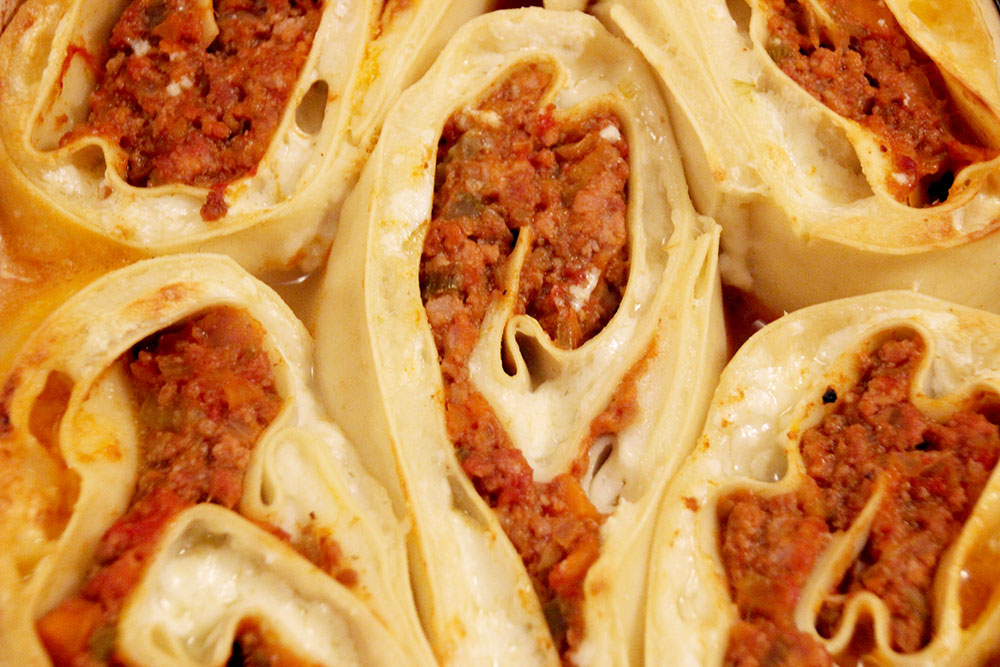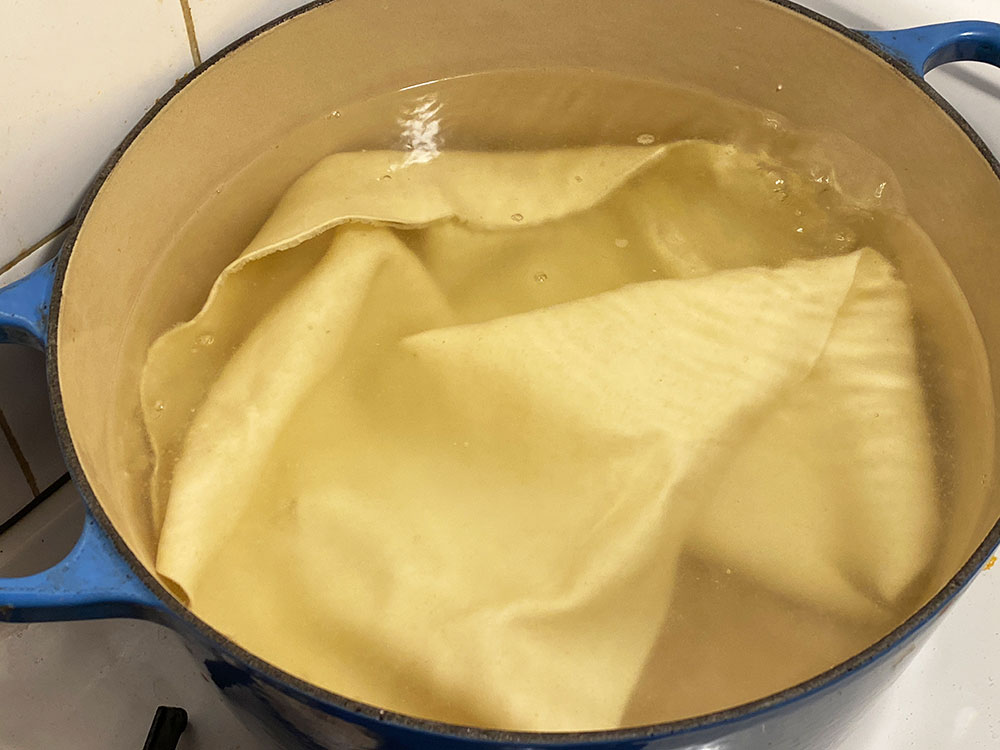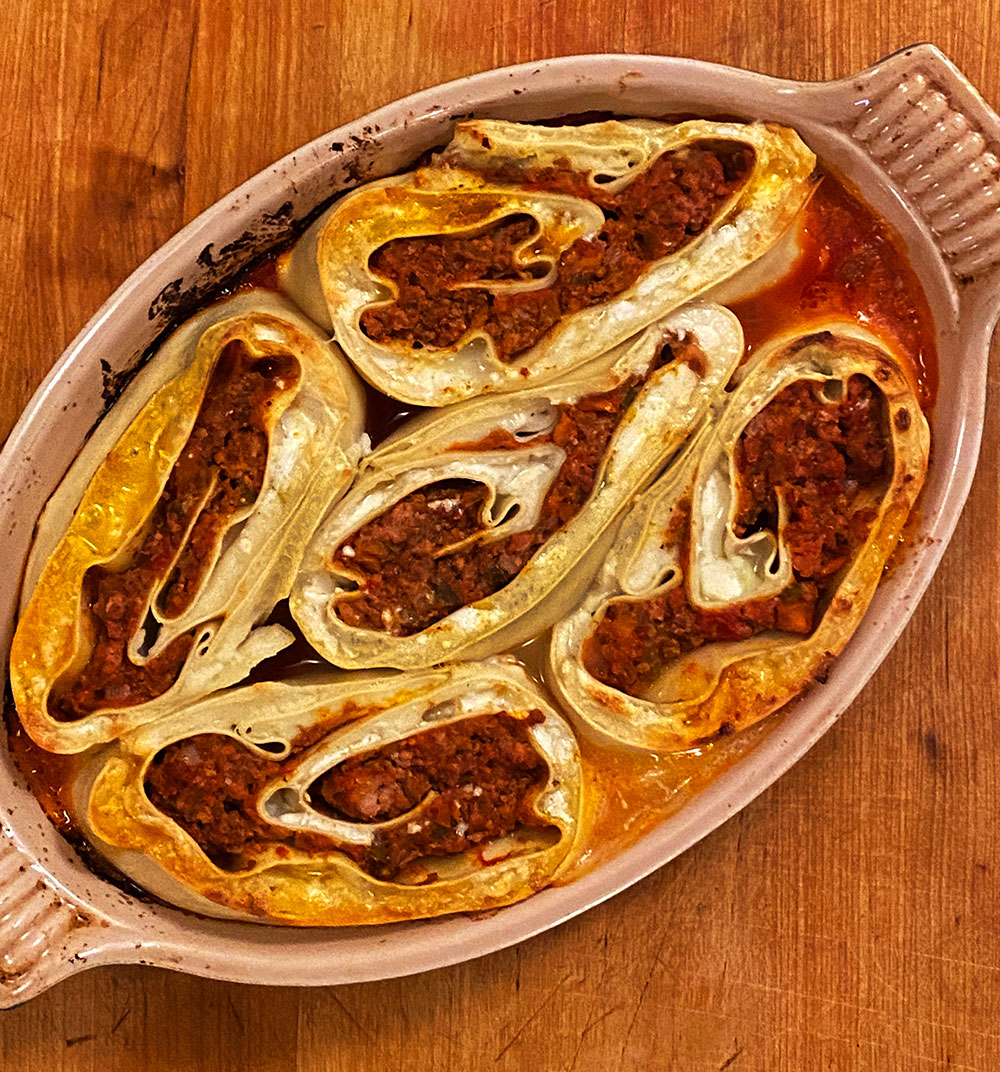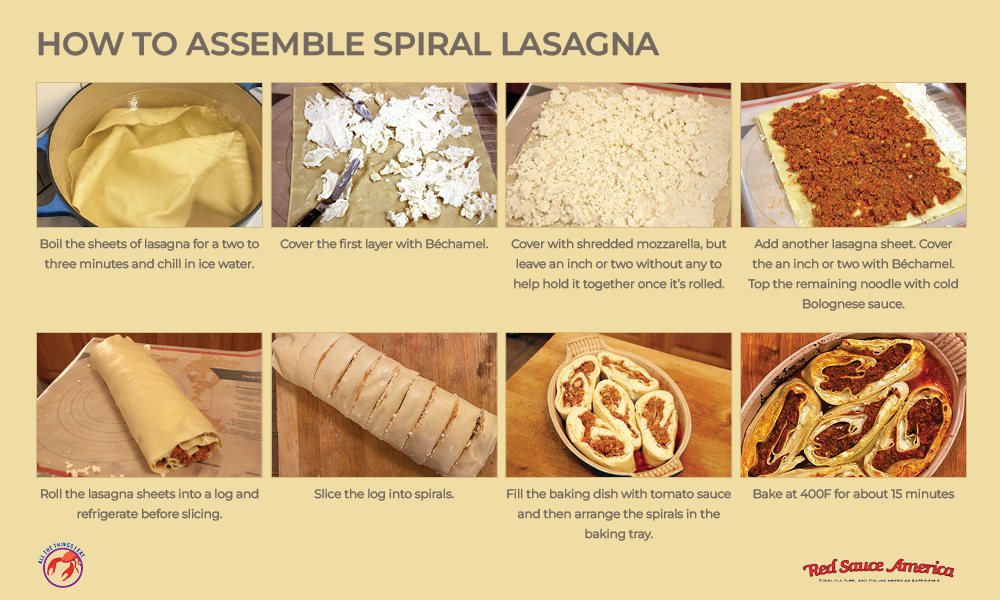I Made the Viral Don Angie Spiral Lasagna and I Survived — Just Barely.
By Ian MacAllen on Tuesday, December 12th, 2023 at 7:12 pm

Chefs Angie Rito and Scott Tacinelli founded Don Angie in 2017, a modern Italian American restaurant celebrating the red sauce cuisine synonymous with Italians in America. The restaurant has achieved plenty of acclaim, earning and then losing a Michelin star, publishing a popular cookbook under the title Italian American, and achieving fame on social media like TikTok. Perhaps no better symbol of their success is the famous spiral lasagna dish.
I began researching my book, Red Sauce: How Italian Food Became American about the same time that Don Angie was rising in the ranks of new restaurants in New York City. I conceived of the book during a night of drinking house red wine at the now permanently closed Trattoria Spaghetto, a traditional red sauce joint in the West Village a few blocks south of Don Angie.
The New York Times reported on Don Angie in 2018 in the aptly titled story “Red-Sauce Italian Cooking Finds a Future at Don Angie.” It’s funny to think that five years later, red sauce is having something of a resurgence, not just at Don Angie but in dining more generally. In 2020 when I was writing the epilogue of the book, I did reflect briefly on this growing interest in the classic Italian American cuisine.
At the time, I said of Don Angie, they are “mixing new American flavors with classics like lasagna.” Even then, the lasagna was one of their best selling dishes. The iconic pinwheels even became the cover photo of their cookbook. Despite the lasagna’s infamy, I still haven’t had the opportunity to eat the restaurant’s dish.
The main problem with the Don Angie lasagna is that booking a table at the restaurant is nearly impossible. Walk-ins are limited too, with lines forming an hour before service. But then Eater recently posted a video about the restaurant and featuring both Angie Rito and Scott Tacinelli discussing some of the popular dishes, including the lasagna. Midway through the video, they go through the motions of making the lasagna. That got me thinking. I could just make my own.
I decided to start this project on a Sunday afternoon. Plenty of time, I thought, on my way to the store. By the time I returned home, I resolved to make only the base bolognese sauce. I would prepare the actual lasagna the following night, on Monday.
The bolognese needs to cool before stuffing it into the lasagna, and preparing it a day ahead of time is recommended. So Sunday night I made a double batch of bolognese. I even made up some fresh tagliatelle pasta for dinner — it’s the only pasta to correctly pair with a bolognese sauce — and reserved the rest of the sauce for the lasagna.
I made the bolognese from my own recipe. I swapped half the ground beef for ground pork, since in the Eater video, they referred to the filling as a sausage bolognese. I took this to mean having pork. I’m sure there are a few special herbs and spices that were not in my version, but it was quite good nevertheless. It was only the following day did I consider there might be an actual recipe online. (Their recipe does include sweet Italian sausage).
Monday afternoon came along. The bolognese has chilled overnight in the refrigerator. I cook up a light tomato sauce, again using my own recipe (I added onions, no basil). Only when it came time to make the Béchamel did I think maybe it was time to look up a recipe from them. That’s when I found this version of the Don Angie lasagna recipe from the Today show appearance.
Now having made part of this recipe, I can tell you that there is no possible way this recipe has been adapted for home use. I cut the Béchamel ingredients in half and still have enough for at least a second lasagna roll. I mostly followed their recipe, but couldn’t find the bay leaves, so I left them out.
I have never made a lasagna with Besciamella (Italian Béchamel) sauce. Béchamel is one of the five French mother sauces and I’ve made plenty of it while cooking through Julia Child recipes, but its a lot less common in lasagna made in the Italian American tradition. Instead, ricotta cheese is often used, owing to the influence of southern Italian cuisine. Neapolitan lasagna recipes are more likely to have ricotta than northern variations where butter was more available. Traditional lasagna bolognese, however, is filled with Besciamella sauce.
Every region in Italy has their own style of baked lasagna, often using local ingredients. However, in more recent years, Lasagna Bolognese has grown in popularity. It can be found not just in Bologna but across Italy. And Italians have also brought the recipe with them across the European Union. However, in the United States, southern style cooking was more influential, and probably a contributing factor into why Italian American lasagna is more likely to have ricotta.
I had the bolognese ragù in the refrigerator, the tomato sauce cooling on the stove, and the Béchamel strained and cooling. I turned my attention to the lasagna sheets.
At this point I believe it is important to point out that Don Angie’s kitchen has a professional pasta machine that pushes out big sheets of lasagna. I, on the other hand, have a roller attachment for a KitchenAid mixer that makes, in a best case scenario, six inch wide sheets.
From the beginning I knew I was at a disadvantage. I planned on merging two, six-inch strips of lasagna to get the twelve-by-twelve square Don Angie uses for their lasagna. The Don Angie lasagna is made by layering the ingredients onto these sheets and rolling it together like a Swiss roll. After the log is made, it is refrigerated to tighten it up and hold it all together. Only then is it cut into large medallions that are arranged in the baking dish.
Normally I would just make a fresh pasta recipe with flour and egg and knead it until the texture felt correct. This technique is how I made the tagliatelle the night before. But I followed the pasta recipe in included on the Today show appearance.
The recipe included a huge amount of egg yolks and turned the dough a beautiful shade of yellow. The recipe suggested mixing it all in a food processor, and I started with that but after about fifteen seconds the dough had gotten too thick. I could hear the motor struggling. Instead of burning out the food processor I pulled the dough and combined it further in the stand mixer. However, I noticed the dough was much wetter than the pasta dough I usually worked with. I was hoping an extra long rest period would help solve that texture problem. It did not.
The dough proved too sticky for my roller. I even added in flour, kneaded the dough again, and let it rest and still found it was too sticky. In my experience, resting dough is the most important step in getting a smooth operating through the rollers, but no such luck this time.
I decided I would have to finish the sheets with a hand rolling pin. I ran the balls through the dough just enough to get it to a basic flat disc. I was also probably overworking the dough at this point, but I intended to finish rolling them out with a hand rolling pin to get the full size. Then I heard a crash from the bathroom.
The toddler had smashed a glass tumbler. Glass shards were everywhere. It was at that moment I decided to pack away the sauces and the cheese I had grated, throw away the pasta dough, and and try again on the third day.
Tuesday afternoon at lunch I walked over to Savino’s Quality Pasta. I hoped they would have fresh lasagna noodles and I thought it might be easier to stitch together their pasta than try making the perfect sheets from scratch. Even better though, they only sold lasagna full lasagna sheets — twelve-by-seventeen inches.
At home I cut the sheets into squares. The next step was figuring out how to boil this giant sheet of pasta, and then cool it in ice water. The restaurant has larger pots and cools their noodles in deep, stainless steel hot table trays. My largest pot was a Le Creuset 28, 6.7 liters. It wasn’t quite large enough for the whole sheet of pasta, but it was close enough. I then filled my largest stainless steel mixing bowl with salty ice water to cool down the pasta after cooking.

The pasta sheet cooked for about two to two and half minutes. It was hard to gauge if it was finished. The pasta was still delicate and I worried about breakage. Then it from the boiling water into the ice bath. Once it was cool it was easier to handle. While it was hot, I was using tongs and the sheets did get a small puncture wound in places, and I risked tearing it.
I cooked up three sheets, but only needed two. Now came the easy part – at least, the easier part. I used an offset spatula to spread the béchamel across the noodle, although I should have let this come to room temperature. It was thicker than I really wanted it to be, and I was still worried about ripping the pasta sheet again.
I then dumped a big pile of mozzarella on top. I realized in retrospect that the Don Angie recipe uses low moisture mozzarella (think Polly-O blocks). I had instead shredded two balls of “fresh” BelGioioso cheese. I topped this with grated parmigiana.
Then it was time for a layer of bolognese. Again, had it come to room temperature, it likely would have spread more easily. I also suspect the restaurant uses extra finely ground meat.
Then I rolled it all up into a giant log and refrigerated for a while.

I took out our stoneware dish and layered in some sauce. I prefer the stoneware to PYREX baking pans because the glass dishes get hotter and faster. They tend to burn sugars more easily and the tomato sauce has plenty of sugars. My pinwheels were huge and while the restaurant gets six per two-person serving, I only squeezed in five. I still had more pinwheels left and the surplus I put in half of a glass baking dish.
The whole thing should cook in fifteen to twenty minutes. I suspect I was baking at a slightly lower temperature than the restaurant because the noodle edges never didn’t quite got the bright golden brown. I could have left it in longer to get more color, but the truth is I prefer slightly less crispiness. Also the surplus lasagna in the glass pyrex was already starting to burn the tomato sauce in the tray. And after three days of work, we were ready to eat and didn’t want to wait any longer. (plus we were trying to eat before the toddler’s bedtime).

One thing I did skip was adding globs of Béchamel sauce to the final plate. I didn’t have much room in the dish because the pinwheels were so big. I don’t think I missed it.
The lasagna was delicious, and the Béchamel sauce was an amazing part of the dish. The texture and consistency was thicker and smoother than ricotta in lasagna, and while on its own is relatively bland, it created a compliment to the acidity of the tomato sauce and the meatiness of the ragù. The edges were crispy on each pinwheel, and a few more minutes in the oven would have crisped them up even more. Ultimately though it might be easier and faster to simply wait on line at Don Angie.

Ingredients
Tomato Sauce (one can whole tomatoes)
Porky Bolognese Sauce (about 1 lb pork)
Béchamel Sauce (about 1 stick of butter / quart of milk)
Two 12 x 12 sheets of lasagna
1 lb Mozzarella Cheese
Parmigiana Cheese
Instructions
DAY 1 – PREP
Prepare a bolognese sauce one day in advance.
DAY 2 – PREP
Prepare tomato sauce and allow to cool.
Prepare bèchamel sauce and allow to cool.
Prepare or purchase fresh lasagna sheet.
Grate Mozzarella and Parmigiana Cheese
Fill a large bowl with salted ice water
Boil salted water
Cook Lasagna sheets one at a time for 2 to 3 minutes
Immediately chill in ice bath
DAY 2 – ASSEMBLE
Spread Béchamel sauce on one lasagna sheet
Top with parmigiana and mozzarella, leaving an inch or two exposed
Layer another cooked lasagna sheet
Add Béchamel to about one to two inches
Spread bolognese sauce across the remaining noodle
Roll up into a log
Refrigerate.
Slice into spirals about 1 inch wide.
Add tomato sauce to the baking tray.
Arrange spirals in the tray.
Bake at 400F for 15 to 20 minutes.

